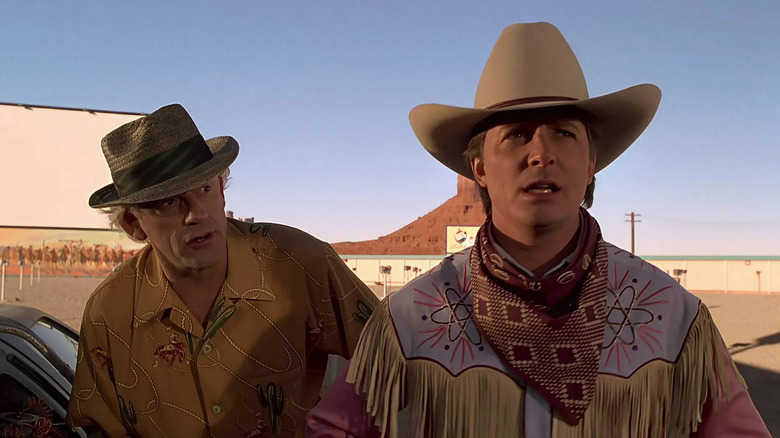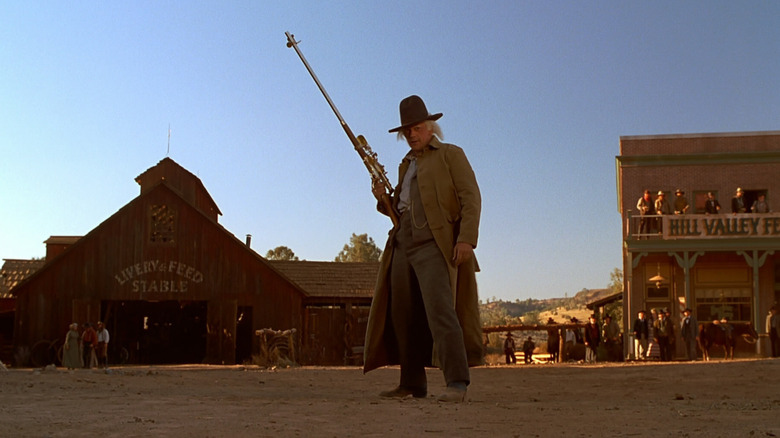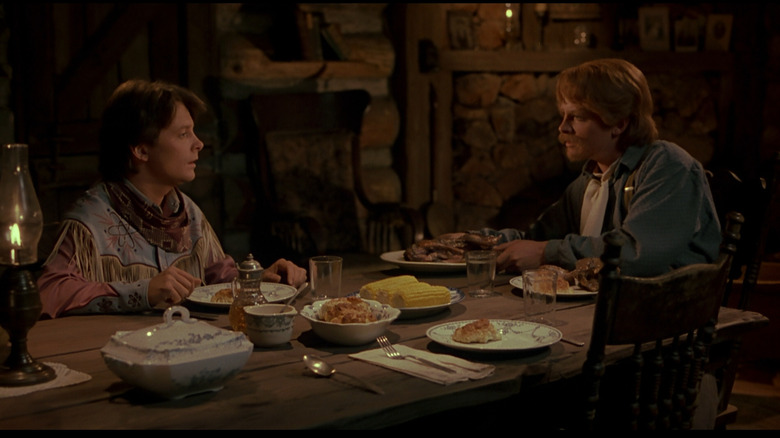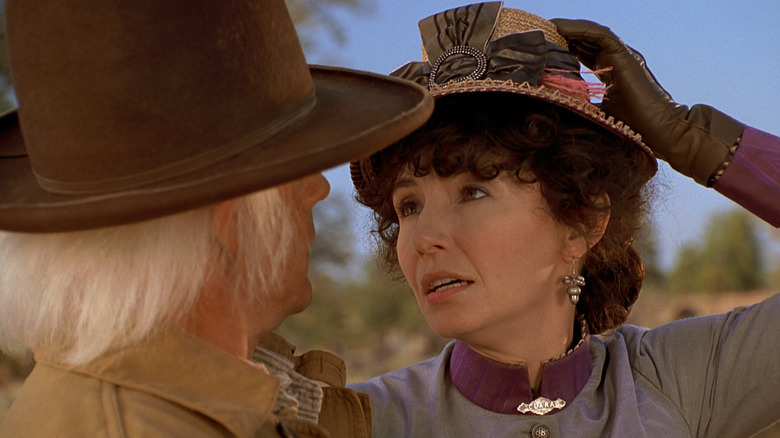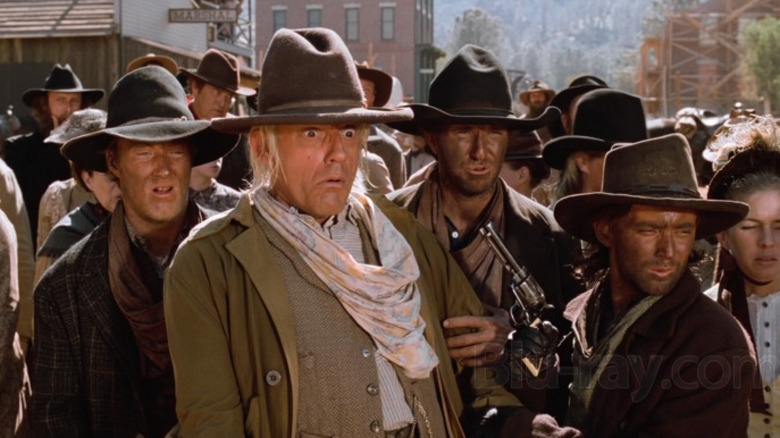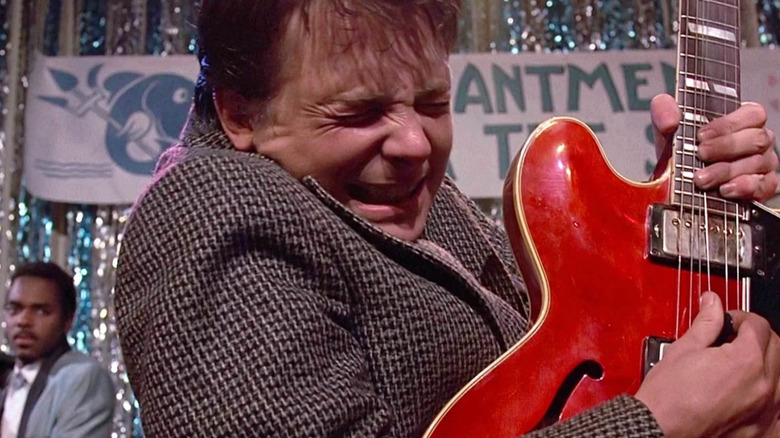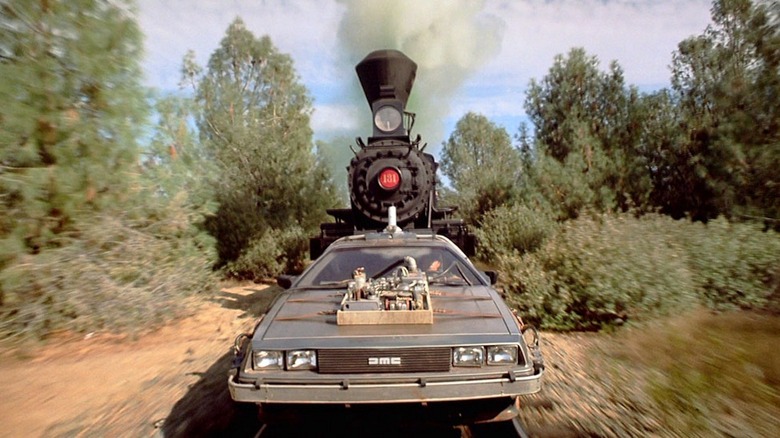Great Scott! Could Back To The Future 3 Be The Best Back To The Future Movie?
The "Back to the Future" films are incredibly beloved, with a unique impact on pop culture that's almost hard to quantify. Robert Zemeckis' 1985 film "Back to the Future" spawned two sequels, a video game, and even a musical, as well as providing the genesis for the adult cartoon "Rick and Morty." The first movie is a zany tale of down-on-his-luck teenager Marty McFly (Michael J. Fox) who ends up traveling through time in a DeLorean with the help of mad scientist Doc Brown (Christopher Lloyd), wreaking havoc on the timeline and engaging in all kinds of silly time travel tropes along the way. The second film is a direct continuation of the first, with time travel to 1955 and 2015 to try and create the best future for Marty and his family. It's not as beloved as the first movie, but folks are still pretty fond of it. Then there's the "Back to the Future Part III," which I've generally heard derided as the worst of the three films. I'm here to argue that, actually, "Back to the Future Part III" is the best film in the "Back to the Future" trilogy.
This may sound crazier than trying to get a DeLorean to go 88 miles per hour to travel through time, but the third movie is a funny and sweet family film that stands well on its own while lacking some of the more frustrating elements of the first two movies. Many people remember "Back to the Future" through rose-tinted glasses, but without that nostalgia to lean on, the first two movies can be difficult to love. "Back to the Future III," on the other hand, is pure joy that has (mostly) aged well, making it the best of the bunch.
A quick recap of the madcap beginning
The very beginning of "Back to the Future Part III" references the first two films, as the second and third films were shot at the same time and released within months of one another, but things are pretty well recapped so that someone could very easily understand everything in "Part III" without ever seeing the first two entries. After Doc Brown disappears in the DeLorean, leaving Marty in 1955, Marty must team up with 1955 Doc to chase after him. Marty goes back to 1885 and ends up finding Doc in the old American West, living in a frontier town. Marty, with foreknowledge of the future, knows that Doc is going to die in about a week, and tries to convince him to fix the DeLorean and head home. Unfortunately, the two need gasoline in order to get back to the future and are working on getting some when Doc falls in love with a woman named Clara (Mary Steenburgen) and decides maybe he doesn't want to go back at all.
Marty manages to get some help from his ancestors, played by Fox and Lea Thompson, who played his mother in the first film, and it's honestly a total blast seeing Fox act with himself. The special effects are pretty incredible for their day, giving Marty the chance to interact with his great-great-grandfather Seamus and allowing Fox to play two members of the McFly family. (It also gave him the chance to play a character closer to his own age at the time!) Seamus helps impart some important lessons to Marty and helps him become a better, more mature young man.
Room for growth
Marty ends up in the Old West wearing a goofy pastel 1950s country western outfit and calling himself "Clint Eastwood," which is the kind of earnest ridiculousness only Fox could pull off. While Fox gets plenty of chances to be a smart-alecky teenager who's sort of a nerdier Ferris Bueller in the first two movies, "Back to the Future Part III" really gives him a chance to grow. Both Doc and Marty have a kind of arrested development that finally gets addressed in "Part III," as Marty tries to convince Doc that he needs to return to his own time and realizes that part of that is a codependence he has with the scientist. In the end, both Doc and Marty realize that they are the architects of their futures, and that nothing is written in stone, which is a great message about self-determination in the face of "destiny."
There's also an examination of the dangers of time travel, with Doc genuinely regretting that he ever built the DeLorean. It never goes too far, which would bog down the movie and make things a bit too depressing for a family film, but it's a moment of understanding for the repercussions of his and Marty's selfish actions. The movie also gives us something I never knew I needed until I got it: a romance for Doc Brown.
A love story worth celebrating
One of the most wonderful things about "Back to the Future Part III" is the romance between Doc and Clara. It's still pretty rare to see romances between older characters at the cinema, and it was even rarer in 1990, when the movie debuted. Marty gets his own love interests in both films, although in the first it's his teenage mother that's interested in him due to some time travel confusion. While Marty's relationship with his girlfriend Jennifer (Elizabeth Shue) in "Part II" is pretty cute, the incest trope with his mom in the first movie is gross, and Doc's love story with Clara is honestly lovely. Both Doc and Clara are unique individuals who don't really fit into what society expects of them, and they find a mirror in one another's eccentricities. The actors have great chemistry and it's fun to see Lloyd play the romantic lead, sadly a rarity in his career.
Everything the first movie gets wrong with its love story, "Back to the Future Part III" gets right, replacing a whole lot of ickiness with something heartfelt and narratively satisfying. The two first realize their chemistry when discussing their shared love of science fiction author Jules Verne and share a kiss under the stars, which is the height of romance.
An infectious sense of fun
The Western setting of "Back to the Future Part III" is a big part of what makes it shine. Combining the silly fun of time travel buffoonery with some great jokes about movie Westerns easily makes it the funniest movie of the trilogy. It also means there's an old-fashioned showdown that doesn't go according to plan, some fun on horseback, and even a killer climax sequence where the heroic duo uses a locomotive to get the DeLorean up to speed. It has the same charm as the very best holodeck episodes from "Star Trek," with actors and crew getting to run wild in a new genre and having an absolute blast while doing it. That fun is infectious and it makes the comedy funnier and the drama even more rousing.
The second and third movies were shot consecutively, and by the time they made the third entry, the cast and crew had probably become pretty tight-knit. There is a warmth to "Back to the Future Part III" that's almost difficult to describe, as if the fun the folks had making it can be felt right through the screen. The first two movies have their own great moments, of course, but they lack that feeling, and the first movie has some pretty major problems that can make it hard to love for certain audiences.
The problems with the original
Here's the thing: "Back to the Future" is a brilliantly made movie that is almost perfect, but those imperfections can feel like a knife in the ribs if you're the wrong person. I had never seen the movies as a child and finally made the decision to watch them a few years ago, only to be shocked to find out that not only is Marty's dad (Crispin Glover) a peeping Tom who is never really reprimanded, but a climactic scene revolves around the violent near-rape of Marty's mother Lorraine (Thompson). The scene is pretty rough, with Biff (Thomas F. Wilson) assaulting Lorraine in the back of a car as she desperately tries to fight him off. While the assault is interrupted, it's insinuated that the reason the older version of Lorraine from the original timeline is so depressed is because of her trauma from the event. As great as it is to engage with the idea of trauma in a movie like this, it's handled really poorly and she's never actually the focus of her own story, because everything revolves around Marty.
Another problem with this focus on Marty is that some of the humor rewards him at the expense of others, often marginalized individuals. The biggest example is during the now-famous scene where he plays rock and roll for a crowd in 1955, and while the joke that he inadvertently altered the timeline by introducing rock is kind of funny, it comes at the expense of the Black musicians he upstages, as well as the real-life Black musicians who actually did create the genre. Since white artists stole from Black ones in reality and gained more success, the joke feels especially egregious.
A trilogy-ending treat
When my nephew gets old enough for me to start teaching him about the magic of the movies, I know I'm going to want to sit down with him and watch "Back to the Future Part III" and watch his face light up at all of the great gags. It's a wonderful family flick almost devoid of problematic material (there is the stereotyped depiction of Indigenous people, but that's something that we could talk about together), while I feel like watching the first or second films with him could be really uncomfortable due to the incest jokes and rape scene. The "Back to the Future" movies are supposed to be something the whole family can enjoy, but the first movie can make that pretty difficult.
That's not to say that there's anything wrong with loving all three movies, and there is definitely more at play than just nostalgia when it comes to why they're so loved. They're well-crafted with a perfect duo at their center and it's hard not to love Doc and Marty and their wacky adventures because of Lloyd and Fox, I just wish that they had a little more consideration for more diverse audiences.
Thankfully, "Back to the Future III" rules, and it will always be my favorite.
